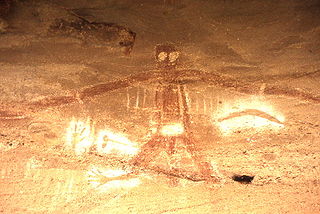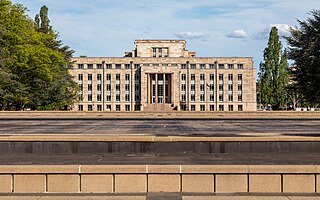| Name | Year established | Location | Description and significance | Preservation and access |
|---|
| Hotel Canberra | 1922-26 | Yarralumla | Hotel Canberra was designed by architect John Smith Murdoch in the Garden-Pavilion style drawing strong influences from American Prairie, Californian Bungalow and Australian Colonial styles. | The Hotel is open to the public and operated by Hyatt, it is listed by the National Trust. |
| Old Parliament House | 1927 | Parkes | | Open to the public as a museum and home of the National Portrait Gallery. Commonwealth Heritage List |
| Ian Potter House | ~1927 | Acton | The exterior of the house is in Inter-War Georgian Revival style and was designed by Anketell and Kingsley Henderson. The house was originally used to house female public servants. | Listed on the ACT Heritage Register |
| Canberra Hospital Administration Building, former | 1941-43 | Acton | | Many of the old hospital buildings are now used by the Australian National University. Listed on the Commonwealth Heritage List, RSTCA Register |
| Commencement Column Monument | 1913 | Capital Hill | The Commencement Column Monument is composed of three foundation stones with inscriptions, set in a hexagonal base (of an intended but never completed column) and was designed by J S Murdoch. | Commonwealth Heritage List |
| Old Canberra House | 1913 | Acton | Designed by J S Murdoch it was the first two-storey masonry structure in the new capital. | Commonwealth Heritage List, Register of the National Estate |
| Melbourne & Sydney Buildings | 1927 | City Centre | The pair of Inter-War Mediterranean style buildings were the earliest major developments in the City Centre | The exterior and remaining original interiors are protected by the ACT Heritage Register. They are still used for commercial and residential purposes. |
| Canberra School of Art | 1939 | Acton | A two-storey rendered brick symmetrical Art Deco style school with central clock tower. | Commonwealth Heritage List, Register of the National Estate |
| The Lodge | 1927 | Deakin | The Lodge is a two-storey, rendered brick building in the Colonial Revival style with Georgian detailing. It has been the Canberra residence for most of Australia's Prime Ministers. | Annual open days for public viewing, listed on the Commonwealth Heritage List. |
| Ainslie Public and Primary Schools | 1927 | Braddon | The first modern school open in the ACT, designed in the Art Deco style. | RAIA register |
| Gorman House Community Arts Centre | 1924-25 | Braddon | The first hostel completed for the Federal Capital Advisory Committee. It was designed by the Commonwealth Architect John Smith Murdoch in the Garden-Pavilion style. | The buildings are used by various community groups. Many of the buildings are open to the public during regular markets. ACT Heritage Register |
| Yarralumla Woolshed & Outbuildings | 1904 | Adjacent to Yarralumla | Fredrick Campbell built this large woolshed for his nearby property Yarralumla. | The woolshed is available for hire as a party venue. Nominated to the ACT Heritage Register |
| Manuka Swimming Pool | 1930 | Griffith | The pool was an important social hub for early Canberra from 1930 until the 1960s. It is built in the Federal Capital Style. | Open to the public, admission charge. ACT Heritage Register |
| Kingston Powerhouse | 1915 | Kingston | The powerhouse was the first permanent public building in the ACT. It was designed by John Smith Murdoch in the Federal Capital style. | ACT Heritage Register |
| Westlake | 1922 | Yaramulla | Accommodation for construction workers including cottages designed by H M Rolland | Completely demolished. Unrestricted public access to the site. |
| Alt Crescent Buildings & Precinct | | | | |
| Reid Urban Conservation Area | | | | |
| Albert Hall | 1927 | Yarralumla | It was designed by J H Kirkpatrick, R Casboulte and H M Rolland, and is representative of the Federal Style of architecture in early Canberra. | Venue available for hire. ACT Heritage Register |
| Australian War Memorial | 1941 | Campbell | | |
| Belconnen Naval Transmission Station | 1938-1939 | Belconnen | Transmitting station for Bonshaw Receiving Station at HMAS Harman; the 600 ft masts were brought to ground on 20 December 2006. | Register of the National Estate and Commonwealth Heritage List |
| Canberra City Garbage Incinerator | 1938-41 | Yarralumla | One of the few remaining examples of the incinerators designed by W B Griffin and E M Nicholls between 1929-38. | Register of the National Estate |
| Australian Forestry School | 1926 | Yarralumla | | Now part of CSIRO |
| Westridge House | 1928 | Yarralumla | | Private Residence owned by the CSIRO. |
| Institute of Anatomy | | Acton | | The building currently houses the National Film and Sound Archive |
| Mount Stromlo Administration Building | 1924 | | Badly damaged by bushfires in 2003. | Fenced off from the public. Listed on Commonwealth Heritage List. |
| Fenner House | | | | |
| Royal Swedish Embassy | | Yarralumla | | Nominated to the Commonwealth Heritage List |
| Canberra Olympic Pool | 1955? | Civic | Built in the post war International Style the pool was designed by Ian Slater of the Department of Works. | Register of the National Estate |
| Former Forrest Fire Station & Residence | 1938 | Forest | Designed by Edwin Henderson and Cuthbert Whitley, the buildings are an example of typical Canberra inter-war functionalism. | House the Canberra Fire Brigade Museum, Register of the National Estate |
| Canberra Grammar School and Chapel | 1929-64 | Red Hill | Church school complex which is a good example of the inter-war Gothic style. | Register of the National Estate |
| Barton Conference Centre | | | | |
| Braddon Urban Conservation Area | | Braddon | | |
| Forrest Urban Conservation Area | | Forrest | | |
| Mercure Hotel Canberra | 1926-27 | Braddon | | |
| Hotel Kurrajong | | Barton | | |
| Manuka Housing Precinct | | Griffith | | |
| Mackie House | | | | |
| Cater House | | | | |
| Birch House | | | | |
| Fisher Government Housing | | Fisher | | |
| Wilson House | | | | |
| Swinger Hill Stages 1 & 2 Cluster Housing | | Phillip | | |
| Beaufort House | | | | |
| Kanangra Court | | | | |
| Arnold Grove | | | | |
| Forrest Townhouses | | | | |
| Northbourne Housing Precinct | | Dickson & Lyneham | Lyneham. Dickson and Owen Flats were designed by Sydney Ancher. Listed on RSTCA. | |
| Vasey Crescent Houses | | | | |
| Calthorpes' House | | Red Hill | | |
| Dickson Library | | Dickson | | |
| General Bridges' Grave | 1920 | Royal Military College, Duntroon | Memorial Grave of designed by architect Walter Burley Griffin | Commonwealth Heritage List |
| ANZAC Memorial Chapel of St Paul | Commonwealth Heritage List | | | |
| Changi Chapel | | Royal Military College, Duntroon | Commonwealth Heritage List | |
| ANU Drill Hall | | Acton | Commonwealth Heritage List | |
| ANZ Bank Building | | | | |
| Monaro Mall | | Civic | | Now part of the Canberra Centre |
| Colonial Mutual Building | | | | |
| Yarralumla brickworks | | Yarralumla | | Closed to the public |
| Cotter Pumping Station & Electrical Sub-station | | Confluence of the Cotter and Murrumbidgee Rivers | Closed to the public, visible from the Cotter Road. | |
| East Block Government Offices | | Parkes | Commonwealth Heritage List | |
| West Block Government Offices | | Parkes | Commonwealth Heritage List | |
| USA Chancery, Residence & Precinct | | | Yarralumla | |
| Law Courts of the ACT & Precinct | | Civic | | |
| Robert Garran Offices | | | | |
| Canberra Baptist Church & Manse | | | | |
| St Paul's Church of England | | | | |
| Holy Trinity Lutheran Church | | | | |
| Townhouse Motor Inn | | | | |
| RAIA Headquarters | | | | |
| Old Parliament House | Commonwealth Heritage List, National Heritage List | | | |
| Girlalang Primary School | | Girralang | | |
| Corroboree Park | | | | |
| de Quetteville | | Hughes | | |
| Barton Court | | | | |
| John Gorton Building | 1927 (foundation built then cancelled); 1956 (rebuilt) | Parkes | An Art Deco building that was built over the span of several decades. Construction initially began in 1927, before it was quickly cancelled due to budgetary constraints and substandard foundations. Construction started over in 1946, and the building finally opened in 1956. | Listed on the Commonwealth heritage register |
| Irish Embassy | | | | |
| Northbourne Flats | | Braddon & Turner | |
| Manning Clark House | | | |
| Trade Offices | | | | |
| Evans Crescent Housing Precinct | | | | |
| The Pines | | | | |
| Sri Lankan Embassy | | | | |
| Allawah & Bega Flats | | | | |
| Campbell Group Housing | | | | |
| Kingston Transport Depot | | | | |
| Open Systems House | | | | |
| ANU Cottage No 3 | | Acton | Commonwealth Heritage List | |
| CSC Building | | | | |
| Canberra National Seventh Day Adventist Church | | | | |
| Guardian House | | | | |












